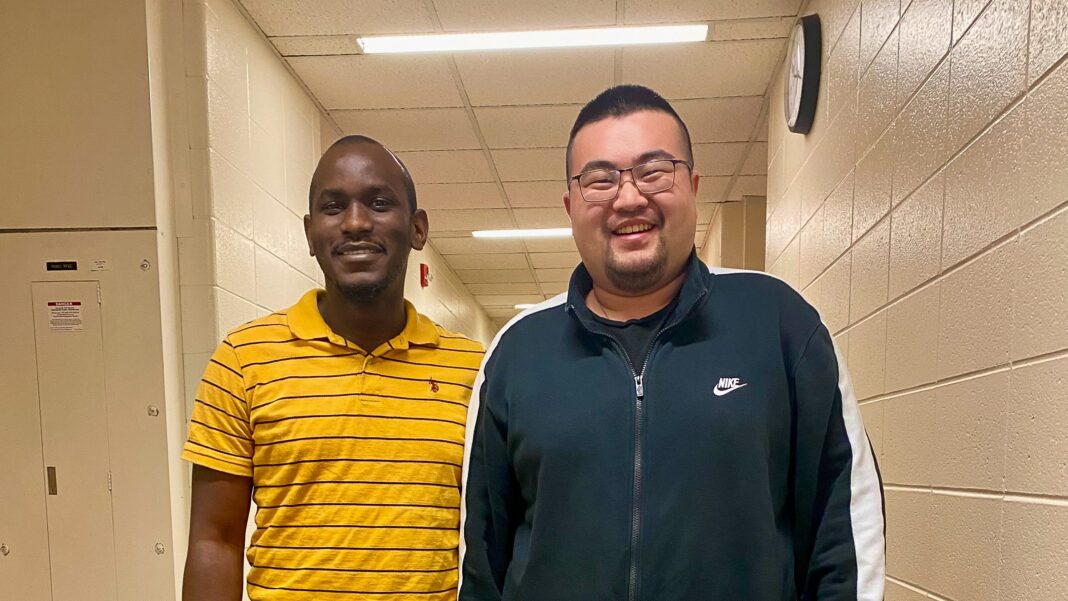## Building the Future: Two Clemson Grad Students Making Waves in Materials Science
The world is built on materials. From the screens we stare at to the bridges we cross, materials science is the invisible force shaping our reality. Now, two Clemson graduate students are pushing the boundaries of this crucial field, earning recognition as emerging leaders with groundbreaking research and a passion for innovation.

Two Clemson Graduate Students Recognized as Emerging Leaders in Materials Science

When they arrived at Clemson University to attend graduate school and conduct research in the lab of Assistant Professor of Chemistry Thao Tran Dominy, the backgrounds of Xudong Huai and Ebube Oyeka could not have been more different. Oyeka already held two master’s degrees in chemistry and had extensive research experience. Huai had just completed his bachelor’s degree in chemistry and had conducted, in his words, “experiments, not research.” Together at Clemson, they worked on research that could lead to new advanced materials for quantum information science.
Their research was selected for inclusion in the Special Collection: Emerging Leaders in Materials Science in the journal Applied Physics Letters (APL) Materials. The special collection highlights groundbreaking research in materials science.

Ebube Oyeka
Oyeka’s background in chemistry and research experience made him an ideal candidate for the project. He contributed to the research by providing expertise in chemical synthesis and characterization. He also helped to develop the theoretical models used to understand the behavior of the materials.
In his free time, Oyeka enjoys playing soccer, reading books, and watching movies. He is also a fan of music and has a passion for photography.
Thao Tran Dominy
As the supervisory role in the project, Tran Dominy provided guidance and mentorship to both Huai and Oyeka. She also contributed to the research by providing expertise in materials science and quantum information science.
Tran Dominy has received numerous awards and recognition for her work, including the US National Academy of Sciences Kavli Fellow, the American Institute of Physics Emerging Leader in Materials Science, and the NSF CAREER Award.
Impact and Future Directions
Potential Impact
The research has the potential to lead to advancements in quantum information science and technology. The new materials could be used in a variety of applications, including electronics, transportation, and medical devices.
The research also has the potential to lead to the development of new materials that can be used in a variety of industries, including energy, aerospace, and biotechnology.
Collaborations and Partnerships
The research was conducted in collaboration with researchers from Poland and the Oak Ridge National Laboratory. The collaboration allowed for the sharing of expertise and resources, which helped to advance the research.
The research also highlights the importance of interdisciplinary collaboration in materials science. The collaboration between chemists, physicists, and engineers helped to bring together different perspectives and expertise, which helped to advance the research.
Practical Applications
The research has the potential to lead to the development of new materials that can be used in a variety of practical applications. The materials could be used in electronics, transportation, and medical devices, among other industries.
The research also highlights the importance of developing materials that can be scaled up for practical use. The materials developed in the research could be used in a variety of applications, including energy storage and conversion, and biomedical devices.
Collaborations and Partnerships
The research was conducted in collaboration with researchers from Poland and the Oak Ridge National Laboratory. The collaboration allowed for the sharing of expertise and resources, which helped to advance the research.
The research also highlights the importance of interdisciplinary collaboration in materials science. The collaboration between chemists, physicists, and engineers helped to bring together different perspectives and expertise, which helped to advance the research.
The collaboration also allowed for the exchange of ideas and knowledge between researchers from different countries and institutions. This exchange helped to advance the research and led to new insights and discoveries.
Future Directions
The research has the potential to lead to advancements in quantum information science and technology. The new materials could be used in a variety of applications, including electronics, transportation, and medical devices.
The research also has the potential to lead to the development of new materials that can be used in a variety of industries, including energy, aerospace, and biotechnology.
The future directions for the research include the development of new materials with specific properties, such as conductivity and magnetism. The research also includes the study of the behavior of the materials under different conditions, such as high temperatures and pressures.
Practical Applications
The research has the potential to lead to practical applications in a variety of industries, including energy, aerospace, and biotechnology.
The materials developed in the research could be used in a variety of applications, including energy storage and conversion, and biomedical devices.
The research also highlights the importance of developing materials that can be scaled up for practical use. The materials developed in the research could be used in a variety of applications, including energy storage and conversion, and biomedical devices.
Future Directions
The future directions for the research include the development of new materials with specific properties, such as conductivity and magnetism. The research also includes the study of the behavior of the materials under different conditions, such as high temperatures and pressures.
The research also includes the study of the use of the materials in different applications, such as energy storage and conversion, and biomedical devices. The study of the use of the materials in these applications could help to advance the development of new technologies and products.
Conclusion
As we conclude this article highlighting Clemson graduate students recognized as emerging leaders in materials science, it is evident that the key points revolve around the groundbreaking research and innovative approaches of these talented individuals. The article sheds light on how their advancements in materials science have the potential to transform various industries, from energy and aerospace to medicine and electronics. The significance of their work lies in its far-reaching implications, as it has the capacity to improve the efficiency, sustainability, and overall performance of materials used in critical applications.
The implications of this research extend beyond the academic realm, with the potential to drive significant economic growth and social impact. As the world grapples with pressing challenges such as climate change, energy scarcity, and healthcare disparities, the innovative solutions developed by these Clemson graduate students offer a beacon of hope. Their work demonstrates the power of interdisciplinary research and collaboration, highlighting the importance of fostering a culture of innovation and knowledge-sharing across disciplines.
As we look towards the future, it is clear that the work of these emerging leaders in materials science will continue to shape the course of human progress. As they push the boundaries of what is possible, we are reminded that the next generation of game-changers is already among us, poised to tackle the world’s most complex challenges. The future is being written by the next wave of innovators, and it is up to us to recognize, support, and amplify their efforts – for it is in their hands that the next breakthroughs will be born.
